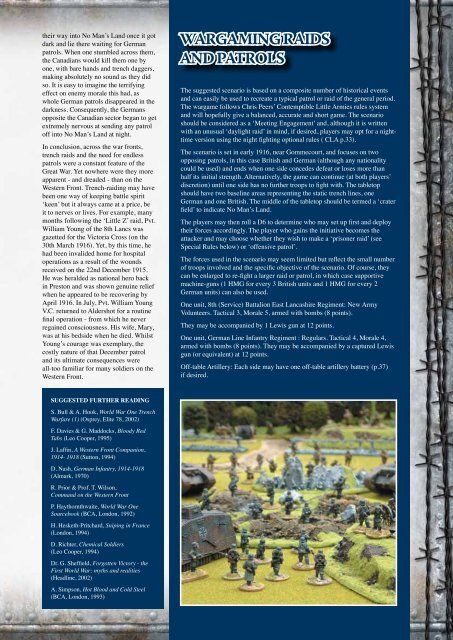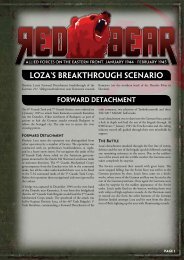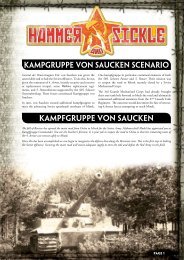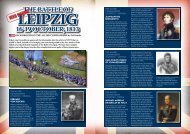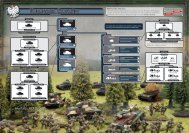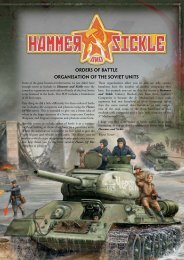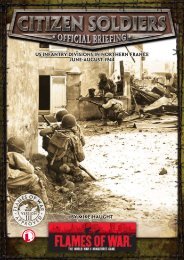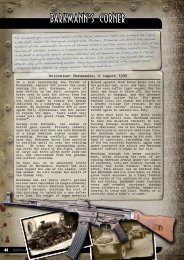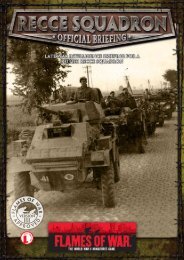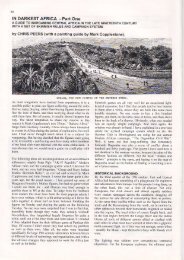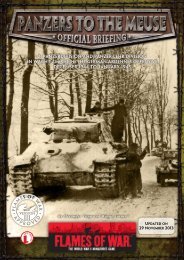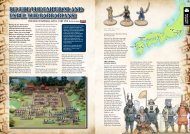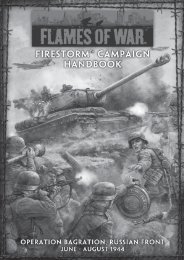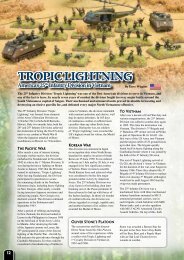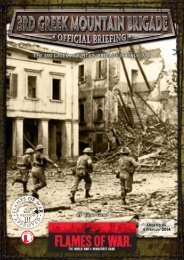You also want an ePaper? Increase the reach of your titles
YUMPU automatically turns print PDFs into web optimized ePapers that Google loves.
their way into No Man’s Land once it gotdark and lie there waiting for Germanpatrols. When one stumbled across them,the Canadians would kill them one byone, with bare hands and trench daggers,making absolutely no sound as they didso. It is easy to imagine the terrifyingeffect on enemy morale this had, aswhole German patrols disappeared in thedarkness. Consequently, the Germansopposite the Canadian sector began to getextremely nervous at sending any patrol<strong>of</strong>f into No Man’s Land at night.In conclusion, across the war fronts,trench raids and the need for endlesspatrols were a constant feature <strong>of</strong> theGreat <strong>War</strong>. Yet nowhere were they moreapparent - and dreaded - than on theWestern Front. Trench-raiding may havebeen one way <strong>of</strong> keeping battle spirit‘keen’ but it always came at a price, beit to nerves or lives. For example, manymonths following the ‘Little Z’ raid, Pvt.William Young <strong>of</strong> the 8th Lancs wasgazetted for the Victoria Cross (on the30th March 1916). Yet, by this time, hehad been invalided home for hospitaloperations as a result <strong>of</strong> the woundsreceived on the 22nd December 1915.He was heralded as national hero backin Preston and was shown genuine reliefwhen he appeared to be recovering byApril 1916. In July, Pvt. William YoungV.C. returned to Aldershot for a routinefinal operation - from which he neverregained consciousness. His wife, Mary,was at his bedside when he died. WhilstYoung’s courage was exemplary, thecostly nature <strong>of</strong> that December patroland its ultimate consequences wereall-too familiar for many soldiers on theWestern Front.<strong>War</strong>gaming Raidsand PatrolsThe suggested scenario is based on a composite number <strong>of</strong> historical eventsand can easily be used to recreate a typical patrol or raid <strong>of</strong> the general period.The wargame follows Chris Peers’ Contemptible Little Armies rules systemand will hopefully give a balanced, accurate and short game. The scenarioshould be considered as a ‘Meeting Engagement’ and, although it is writtenwith an unusual ‘daylight raid’ in mind, if desired, players may opt for a nighttimeversion using the night fighting optional rules ( CLA p.33).The scenario is set in early 1916, near Gommecourt, and focuses on twoopposing patrols, in this case British and German (although any nationalitycould be used) and ends when one side concedes defeat or loses more thanhalf its initial strength. Alternatively, the game can continue (at both players’discretion) until one side has no further troops to fight with. The tabletopshould have two baseline areas representing the static trench lines, oneGerman and one British. The middle <strong>of</strong> the tabletop should be termed a ‘craterfield’ to indicate No Man’s Land.The players may then roll a D6 to determine who may set up first and deploytheir forces accordingly. The player who gains the initiative becomes theattacker and may choose whether they wish to make a ‘prisoner raid’ (seeSpecial Rules below) or ‘<strong>of</strong>fensive patrol’.The forces used in the scenario may seem limited but reflect the small number<strong>of</strong> troops involved and the specific objective <strong>of</strong> the scenario. Of course, theycan be enlarged to re-fight a larger raid or patrol, in which case supportivemachine-guns (1 HMG for every 3 British units and 1 HMG for every 2German units) can also be used.One unit, 8th (Service) Battalion East Lancashire Regiment: New ArmyVolunteers. Tactical 3, Morale 5, armed with bombs (8 points).They may be accompanied by 1 Lewis gun at 12 points.One unit, German Line Infantry Regiment : Regulars. Tactical 4, Morale 4,armed with bombs (8 points). They may be accompanied by a captured Lewisgun (or equivalent) at 12 points.Off-table Artillery: Each side may have one <strong>of</strong>f-table artillery battery (p.37)if desired.Suggested further readingS. Bull & A. Hook, World <strong>War</strong> One Trench<strong>War</strong>fare (1) (Osprey, Elite 78, 2002)F. Davies & G. Maddocks, Bloody RedTabs (Leo Cooper, 1995)J. Laffin, A Western Front Companion,1914- 1918 (Sutton, 1994)D. Nash, German Infantry, 1914-1918(Almark, 1970)R. Prior & Pr<strong>of</strong>. T. Wilson,Command on the Western FrontP. Haythornthwaite, World <strong>War</strong> OneSourcebook (BCA, London, 1992)H. Hesketh-Pritchard, Sniping in France(London, 1994)D. Richter, Chemical Soldiers(Leo Cooper, 1994)Dr. G. Sheffield, Forgotten Victory - theFirst World <strong>War</strong>: myths and realities(Headline, 2002)A. Simpson, Hot Blood and Cold Steel(BCA, London, 1993)


